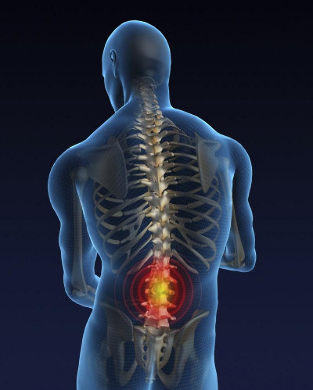In some cases, the patient is sometimes difficult to recover in a standing position. The acute pain in the back can last from a few days to a few weeks.

The causes of acute pain in the back
Most people at least once in life experienced the pain in the back. Although pain or discomfort may appear at any level, the most frequently affected is the lumbar region. This happens because the kidneys are forced to bear the weight of the whole body and the head.
The pain in the back - the second occasion of the call to the doctor, just behind the common cold and the flu.
Generally, for the first time acute low back pain occurs after lifting a heavy object, a sudden movement, an injury, or long sitting in one position.
Acute low back pain, most often, is the result of a sudden traumatic of the muscles and ligaments of the back, lumbar disc herniation of the spine. The pain, in such cases, can be caused by muscle spasms, stretching, or rupture of the muscles and ligaments.
Causes of pain in the lower back include:
- of vertebral compression fractures due to injury or osteoporosis;
- muscle spasm (excessive tension of the muscles);
- hernia;
- sciatica;
- stenosis of the spinal canal);
- the curvature of the spine (eg scoliosis or kyphosis) including disease Chairman Mau;
- the tensile/rupture of the muscles or ligaments of the back;
- osteoarthritis;
- spondylolisthesis;
- infection of the spine (discitis, abscess.
The acute pain in the lower back can also cause systemic diseases:
- diffuse connective tissue disease;
- Ankylosing spondylitis;
- a malignant tumor in the spine;
- the rheumatoid arthritis.
The causes of acute pain in the back, not the problems related to the spine or the tissues of the back:
- aneurysm of the abdominal aorta;
- diseases of the gastro-intestinal tract: pancreatitis, stomach ulcer, cholecystitis;
- the herpes zoster;
- disease pelvic: endometriosis, prostatitis, inflammation of the pelvic region;
- diseases of the retroperitoneal space: renal colic, pyelonephritis;
- pregnancy.
The symptoms
The symptoms of acute pain in the back will vary considerably depending on its causes. You may feel numbness, tingling, of the nature of the pain can vary, as can the severity of the pain: mild discomfort to pain, pain to bear. In addition, the back pain is often combined with pain in the leg, the thigh, the foot. In some cases, there may be a weakness in the leg.
Here are some examples of symptoms of various diseases and conditions:
- when intervertebral hernia: pain in the lower back, often in the leg and pain in the leg sharp pain in the back and is aggravated in sitting position or after sleep. The back pain can give in the buttock, thigh and down the leg to the foot. Can have the sensation of tingling, numbness in the foot and the toes, in rare cases, weakness of the muscles of the leg;
- when the traction of the muscular size: diffuse pain in the lower back, which does not have the pace or the buttock; intensifies when the driving is relaxed to the rest state;
- when the stenosis of the spinal canal: the lower back pain and leg pain in the leg sharp pain in the back, while spinal stenosis is often accompanied by the development of intervertebral hernia; aggravated by standing and walking, reduced to the state of rest, and when turned back on. The pain may be unilateral and bilateral;
- during the consolidation of the connective tissue disease: pain in multiple joints, fever, weight loss, weakness;
- when osteomyelitis: a constant pain, often the normal temperature; the full blood count is normal, the increase of the sedimentation speed (vs) and/or the level of c-reactive protein.
The diagnosis
On the advice of the doctor will conduct a conversation with the patient and ask him some questions about the nature and the severity of the pain and other symptoms, will bring together information on the history and conduct a medical examination. On the basis of data from interview and examination, the doctor can make a diagnosis, or preliminary diagnosis, which need to confirm and/or refine with the help of medical tests. Of medical tests may be different, from blood tests and ending by nerve conduction studies. The most popular of the investigation include:
X-rays

The x-ray is performed to evaluate the state of the bone of the patient. The diagnostics that can be put using an x-ray include osteoporosis, compression fracture and bony growths (osteophytes);
Magnetic resonance imaging (fmri)
The advantage of MRI before the other studies is that, thanks to the MRI, you can obtain high-quality images that are precise, not only the bones but also of soft tissues: muscles, ligaments, blood vessels, nerves, intervertebral discs, spinal cord, etc
The most common are the diagnostics on the findings of the MRI:
- intervertebral hernia;
- the narrowing (stenosis of the vertebral canal;
- ankylosing spondylitis.
Other diagnoses that can be made using MRI:
- ankylosing spondylitis (arthritis);
- infection of the bone;
- the syndrome of the cauda equina;
- fractures, compression;
- discitis (inflammation of the intervertebral disc);
- the abscess of the spinal cord;
- lesions of the spinal cord;
- the tumour on the spine.
A computed tomography (CT)
The tomography also allows to obtain images is not only bone, but also soft tissues, but the quality of the image is lower than the quality of the photos taken during the completion of the MRI, so CT is recommended in this case, if the completion of an MRI for any reason, it is impossible or difficult, for example, if you have a pacemaker or metallic structures in the body.
Treatment
That you can do at home to acute pain in the back?
- the limitation of physical activity on 1-2 days. This will help to relieve the symptoms, and moderating the inflammation in the painful area;
- by applying hot-water bottles or bladder with ice to the painful area;
- the reception otc pain medications. Not worth taking these drugs in greater numbers than it is stated in the instruction, the medication should not be more than 3 days. If the pain persists, see your doctor.
During sleep, it is better to take the position of the embryo and putting a pillow between the legs. If You have the habit of sleeping on your back, place a pillow under your knees or a rolled towel, to deposit the load on the back.
If the cause of the pain in the lower back is more serious, then the patient requires a specific treatment, depending on the disease or condition, which has caused a painful sensation, and there already we can't do it without the help of specialists.
One of the most common causes of acute pain in the lower back, which needs a special treatment, is intervertebral hernia. The treatment of intervertebral hernia is usually conservative, only occasionally physicians resort to surgical methods. There are a large number of conservative treatments for intervertebral disc herniation. Here are a few:
- The medication treatment. The drug treatment includes the receipt of painkillers and anti-inflammatory.
- The stretching of the spine. This stretching does not result in complications relative to the traction on the tables of vector-borne or goods. The stretching of the spine allows to partially restore the power and, as a result, the state of the intervertebral discs, and contributes to the reduction of the size of intervertebral hernia;
- The therapeutic massage. Types of therapy are different. In general, this method aims to achieve relaxation of the muscles of the back, the removal of muscle spasms that often accompany lower back pain;
- Gymnastics, medical. Physiotherapy aims to strengthen the small muscles of the back;
- Girudoterapiya
Girudoterapiya relieves the inflammation around the hernia, reduces the pain syndrome. Is an alternative to painkillers. - A surgical treatment. The surgical treatment of intervertebral hernia, it is recommended only to patients who do not allows for the conservative treatment of the funds, provided that the treatment has been conducted regularly and systematically, as well as patients who started treatment already with symptoms expressed in neurological deficit: the weakness in the foot, paresis, paralysis of the leg, numbness in the groin area, the breach of a control of the functions of urination and/or defecation. All of the above symptoms are indications for emergency operation on the spine.


























